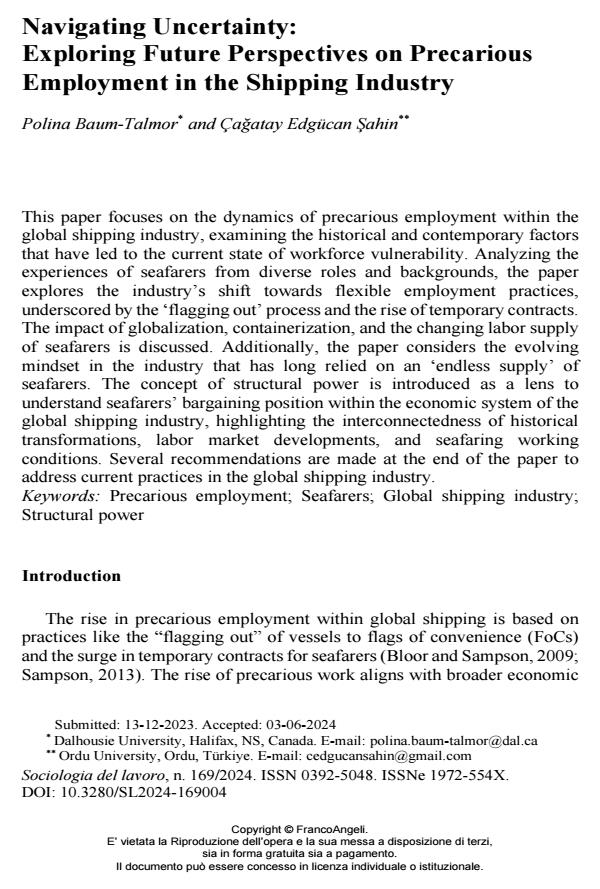Navigating Uncertainty: Exploring Future Perspectives on Precarious Employment in the Shipping Industry
Titolo Rivista SOCIOLOGIA DEL LAVORO
Autori/Curatori Polina Baum-Talmor, Cagatay Edgücan Sahin
Anno di pubblicazione 2024 Fascicolo 2024/169
Lingua Inglese Numero pagine 26 P. 73-98 Dimensione file 249 KB
DOI 10.3280/SL2024-169004
Il DOI è il codice a barre della proprietà intellettuale: per saperne di più
clicca qui
Qui sotto puoi vedere in anteprima la prima pagina di questo articolo.
Se questo articolo ti interessa, lo puoi acquistare (e scaricare in formato pdf) seguendo le facili indicazioni per acquistare il download credit. Acquista Download Credits per scaricare questo Articolo in formato PDF

FrancoAngeli è membro della Publishers International Linking Association, Inc (PILA)associazione indipendente e non profit per facilitare (attraverso i servizi tecnologici implementati da CrossRef.org) l’accesso degli studiosi ai contenuti digitali nelle pubblicazioni professionali e scientifiche
Questo articolo si concentra sulle dinamiche dell’occupazione precaria all’interno dell’industria marittima globale, esaminando i fattori storici e contemporanei che hanno portato allo stato attuale di vulnerabilità della forza lavoro. Analizzando le esperienze dei marinai provenienti da ruoli e contesti diversi, l’articolo esplora lo spostamento dell’industria verso pratiche di impiego flessibili, accentuato dalla strategia del “flagging out” e dall’aumento dei contratti temporanei. Viene discusso l’impatto della globalizzazione, della containerizzazione e del cambiamento dell’offerta di lavoro dei marinai, sottolineando la natura precaria della loro occupazione. Inoltre, l’articolo esamina l’evoluzione del pensiero all’interno dell’industria che per lungo tempo ha fatto affidamento su una “fornitura infinita” di marinai. Viene introdotto il concetto di potere strutturale come strumento per comprendere la posizione contrattuale dei marinai all’interno del sistema economico dell’industria marittima. Alla fine dell’articolo vengono avanzate diverse raccomandazioni per affrontare le pratiche attuali nell’industria marittima globale.
Parole chiave:Lavoro Precario; Marinai; Industria globale del trasporto marittimo; Potere strutturale
Polina Baum-Talmor, Cagatay Edgücan Sahin, Navigating Uncertainty: Exploring Future Perspectives on Precarious Employment in the Shipping Industry in "SOCIOLOGIA DEL LAVORO " 169/2024, pp 73-98, DOI: 10.3280/SL2024-169004